Grains and Pulses
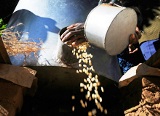
Technical manual for the construction and use of family-sized metal silos to store cereals and grain legumes
01/01/2015
The Technical manual for the construction and use of family-sized metal silos to store cereals and grain legumes was produced in the Division of Rural Infrastructure and Agro-industries (AGS) of FAO as a significant technical contribution to preventing losses in the post-harvest phase of grains and cereals.

Oilseeds | Post-harvest operations
20/04/2014
Oilseeds such as mustard, Niger seed, rape, sesame, soybean or sunflower offer a range of opportunities for small farmers, particularly in sub-Saharan Africa. Oilseed crushing can range from a large industrial scale to manual processing on farm as a small scale agro-enterprise. Home utilization of the edible oils is of great nutritional value and the protein rich by-product “cake” is fed to livestock.

P4P Training Manual for Improving Grain Postharvest Handling and Storage
01/01/2012
The materials in this manual serve as a basic tool for different levels of PHHS trainers working in different contexts and with different end users, with the objective of improving the quality of grain being offered for sale to WFP and other buyers. The manual includes detailed reference materials and...

Cowpea | Post-harvest operations
15/06/2004
Cowpea is a legume that is extensively grown, particularly throughout sub-Saharan Africa. It is a subsistence crop, often intercropped with sorghum, maize and pearl millet. The peas provide valuable protein, the leaves are used as a nutritious vegetable and the rest of the plant serves for animal feed. The plants are drought tolerant and grow well on relatively poor soils. The peas can be consumed fresh or removed from the pods and dried.

Barley: Post-Harvest Operations
15/06/2003
Barley is grown in about 70 million hectares in the world. Global production is 160 million tons. Developing countries accounts for about 18 % (26 million tons) of total barley production and 25 % (18.5 million hectares) of the total harvested area in the world.

Soybean: Post-Harvest Operations
06/07/2002
Soybean is a useful oil and protein source and can be used to improve the nutritional value of traditional foods. The beans are processed to give soy flour, meal or milk products and the oil can be extracted leaving a meal which is used for animal feed.
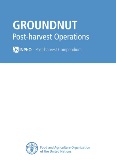
Groundnut | Post-harvest operations
07/06/2002
Groundnut is rich in oil and protein and has a high-energy value. The largest producers are China, India, Nigeria and the United States of America, but many other African and South American countries also have sizeable production. Groundnut provides high-quality cooking oil and is an important source of protein for both human and animal diets.

Maize: Post-harvest Operations
15/05/2002
Maize is widely grown throughout the world and has the highest production of all the cereals with 817 million tonnes being produced in 2009 (FAOSTAT). It is an important food staple in many countries, as well as being used in animal feed and many industrial applications. The crop has tremendous genetic variability, which enables it to thrive in tropical, subtropical, and temperate climates.

Teff: Post-Harvest Operations
14/05/2001
Teff is a staple crop in Eritrea and Ethiopia where it is a native annual grass species but is not widely known around the world. The very small seeds are cooked or fermented and have good nutritional content. The plant is very adaptable to different conditions but is day length sensitive, requiring 12 hours of daylight to flower.

Millet: Post-harvest operations
04/05/2001
Millet is a collective term referring to a number of small-seeded annual grasses that are cultivated as grain crops, primarily on marginal lands in dry areas of temperate, sub-tropical and tropical regions. It is regarded as a subsistence grain grown for food and animal fodder. The largest production is in India and Nigeria. Total world production in 2007 was 31 million tonnes (FAOSTAT).

Cassava | Post-harvest operations
14/10/1999
Cassava is an edible root that provides an important source of carbohydrates for an estimated 500 million people in Africa, Asia and the Americas. World production was 230 million tonnes in 2008, with Nigeria as the largest producer followed by Brazil, Thailand and Indonesia (FAOSTAT).
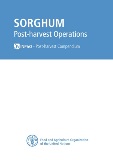
Sorghum: Post-Harvest Operation
14/10/1999
Sorghum is the fifth most important cereal grown with a world production of over 55 million tonnes in 2008 (FAOSTAT). Most varieties are heat and drought tolerant, hence it is an important crop in arid areas. It is an important source of food in Africa, Central America, and South Asia and is also used to produce alcoholic beverages and biofuel.
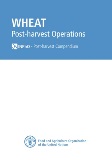
Wheat: Post-Harvest Operations
14/10/1999
Wheat is widely grown around the world under diverse climatic conditions and has been the staple food of the major civilizations in Europe, Asia and North Africa for 8,000 years. As an important staple food used in a wide variety of products, post-production operations play an important role in creating a stable food supply. Wheat is also used to produce animal feedstuffs, starch and ethanol.
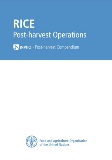
Rice: Post-Harvest Operations
14/10/1999
Rice is a staple food for over half the world's people and has the second largest cereal production after maize with over 685 million tonnes recorded in 2008 (FAOSTAT). China, India, Indonesia and Pakistan are the biggest producers. Rice cultivation requires more water than other cereals and is more labour intensive.

Quinoa: Post-Harvest Operations
06/06/1997
Quinoa (Chenopodium quinoa Wild) is grown in arid and semi-arid areas of the Andes, but it is very adaptable and can be grown at sea level. Its cultivation has spread to more than 70 countries. Quinoa has a protein of high biological value with a high lysine content. It is used both in the human diet and as animal feed. The ripe grain is also consumed, directly or in a processed state.
